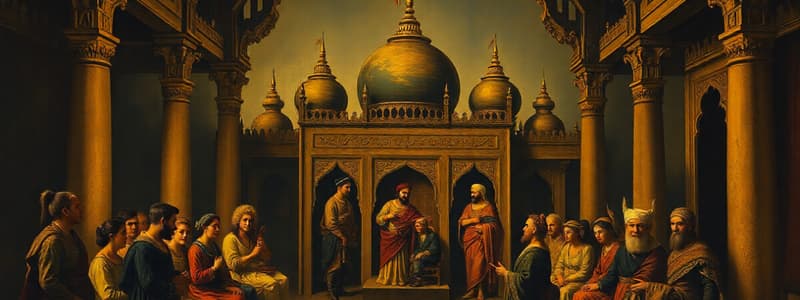Podcast
Questions and Answers
Which empire did Tamerlane notably impact as a consequence of his conquests?
Which empire did Tamerlane notably impact as a consequence of his conquests?
- The Byzantine Empire
- The Holy Roman Empire
- The Mughal Empire (correct)
- The Romanov Empire
What strategy did Tamerlane use to consolidate power among rival tribes?
What strategy did Tamerlane use to consolidate power among rival tribes?
- Religious conversion
- Charismatic warfare and indirect rule (correct)
- Forming alliances and direct governance
- Establishing a centralized government
Which area did Tamerlane invade that led to a brutal conquest in the late 1390s?
Which area did Tamerlane invade that led to a brutal conquest in the late 1390s?
- Beijing
- Delhi (correct)
- Samarkand
- Persia
What contributed to the spread of Buddhism from India to other regions?
What contributed to the spread of Buddhism from India to other regions?
How did Islam primarily spread throughout dar Al-Islam?
How did Islam primarily spread throughout dar Al-Islam?
Which city was the capital of the Islamic world until it was sacked by the Mongols in 1258?
Which city was the capital of the Islamic world until it was sacked by the Mongols in 1258?
What was one consequence of the diffusion of agricultural crops through trade routes?
What was one consequence of the diffusion of agricultural crops through trade routes?
Who was Margery Kemp and what was her contribution?
Who was Margery Kemp and what was her contribution?
What technological advancement was NOT spread through the Mongols?
What technological advancement was NOT spread through the Mongols?
Which traveler is known for his detailed notes and travels throughout dar-Al-Islam?
Which traveler is known for his detailed notes and travels throughout dar-Al-Islam?
Flashcards are hidden until you start studying
Study Notes
Tamerlane's Empire
- Tamerlane, a Turkic-Mongol conqueror, built an empire in Central Asia during the 14th and 15th centuries that rivaled Chinggis Khan's empire.
- Tamerlane's empire had a lasting impact on the Mughal, Safavid, and Ottoman empires.
- Tamerlane consolidated power among rival tribes and expanded his authority throughout the khanate of Chagatai.
- He built his imperial capital in Samarkand.
- He targeted central trading cities to levy taxes on trade and benefit from agricultural production in Persia and Afghanistan.
- He weakened the Golden Horde in the Caucasus region, Russia, and conquered Delhi in India.
- Tamerlane did not create a centralized government, but ruled indirectly through leaders who formed alliances with him.
The Influence of Tamerlane's Empire
- The Mughal, Safavid, and Ottoman empires emerged from the Timurid Empire, reflecting Turkish, Mongol, and Muslim influence.
The Impact of Trade on the Spread of Culture and Belief Systems
- Buddhism spread from India to Southeast Asia, China, and Japan via the Silk Road.
- Islamic beliefs spread throughout dar Al-Islam, facilitated by trade and adopted by the Swahili states.
- The spread of Islamic beliefs led to the Swahili language combining Bantu and Arabic.
- Muslim scholars translated ancient Greek and Roman texts, contributing to the Renaissance in Europe.
Urbanization and Development
- Cities like Hangzhou in China, Samarkand, and Kashgar grew due to their location on trade routes like the Silk Road.
- Baghdad, the capital of the Islamic world, declined after the Mongols sacked the city in 1258, ending the Abbasid Dynasty.
- Constantinople, the political and religious capital of the Byzantine Empire, declined after the Ottomans captured it in 1453 and renamed it Istanbul.
Increased Travel
- Mongol security on trade routes enabled travelers like Ibn Battuta, Marco Polo, and Margery Kemp to make extensive journeys.
- Ibn Battuta, a Muslim scholar, traveled throughout dar-Al-Islam and documented his observations.
- Marco Polo traveled from Italy to China, documenting his experiences with Kublai Khan and the wealth of China.
- Margery Kemp, a Christian mystic, traveled to holy sites in Christianity, documenting the practices of Christianity throughout Europe and the Middle East.
Agricultural Diffusion and Population Growth
- Trans-Saharan trade, the Silk Road, and the Indian Ocean Trade facilitated the spread of agricultural crops.
- The introduction of bananas to Africa from Southeast Asia led to population growth in Bantu states.
- Champa rice from Vietnam was introduced to China, allowing for multiple harvests per year and increasing population.
- Citrus fruits were introduced to Europe by Muslim traders.
Environmental Consequences and Disease
- The spread of the Bubonic Plague was facilitated by the expanding Mongol Empire and its trade networks.
- The plague killed a significant portion of the population.
Studying That Suits You
Use AI to generate personalized quizzes and flashcards to suit your learning preferences.




